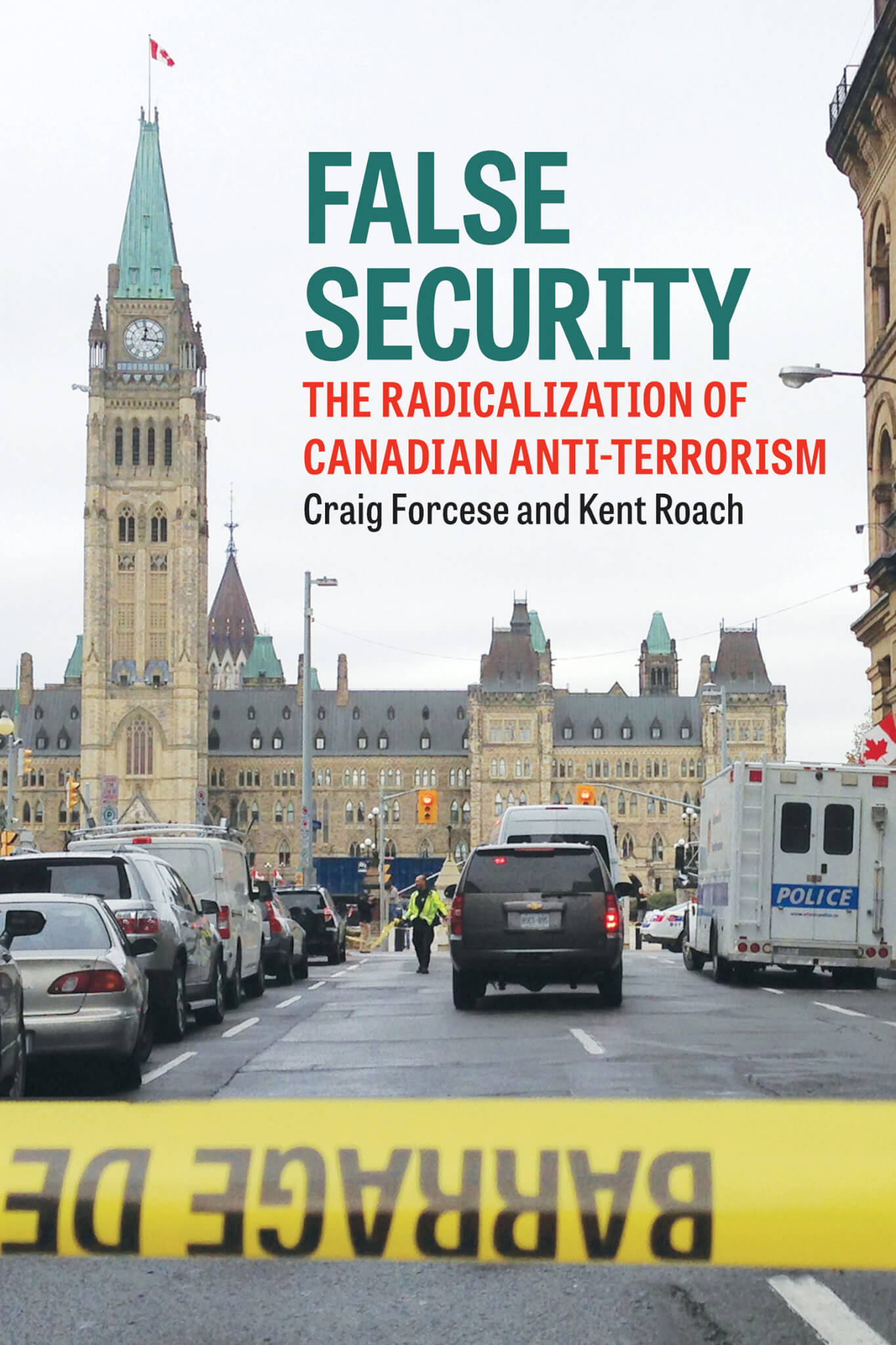What follows is adapted from material contained in False Security: The Radicalization Of Canadian Anti-terrorism, by Craig Forcese and Kent Roach.
 Irwin Law
Irwin LawOn October 20, 2014, Martin Couture-Rouleau drove a car into two uniformed members of the Canadian Armed Forces in a Saint-Jean-sur-Richelieu, Quebec, parking lot, killing Warrant Officer Patrice Vincent. Authorities had seized Couture-Rouleau’s passport that summer, in order to stop the recent Muslim convert from leaving Canada to fight with the Islamic State of Iraq and Syria (ISIS). Nevertheless, he had not been arrested or charged under applicable new terrorism offences that Canada had enacted in 2013, nor did authorities restrict his liberties with an anti-terror peace bond (a form of restraining order).
Two days later, Michael Zehaf-Bibeau—whose passport application had also been delayed within the government for reasons that remain unclear—murdered Corporal Nathan Cirillo, a soldier standing ceremonial guard at the National War Memorial. Zehaf-Bibeau fired three shots from his rifle into the back of the defenceless Cirillo. Despite intelligence issued a few days before about increased threats of terrorism, Zehaf-Bibeau incredibly was then able to enter the Centre Block of the Parliament building, where the prime minister, the leader of the opposition, and some 230 members of Parliament were in caucus meetings. He wounded the unarmed parliamentary guard who tried to disarm him before being killed by Sergeant-at-Arms Kevin Vickers and RCMP officers.
Canadians and their political representatives were united in their shock and grief. But only for a time. Prime Minister Harper introduced Bill C-51 in an election-style rally on January 30, 2015. He defended the legislation on the basis that “violent jihadism is not a human right. It is an act of war, and our government’s new legislation fully understands the difference.” The bill made the most far-reaching changes to Canadian security laws since 9/11.
Bill C-51 was introduced not only in response to the October 2014 attacks, but also as a political reaction to January 2015 terrorist attacks in Paris and Copenhagen. Those attacks targeted the Jewish community and those perceived to have insulted Islam, most famously the French satirical newspaper Charlie Hebdo.
The cold Canadian winter of 2015 swirled with security fears. Police charged two people with conspiracy to commit murder on Valentine’s Day, alleging that they had planned to shoot people in a Halifax mall. Minister of Justice Peter MacKay stated that this was not an act of terrorism because of the absence of a “cultural” element (a peculiar turn of phrase given the absence of such a concept in the law). For some, it was a coded phrase suggesting a double standard for Islamic-related terrorism; in any case, the arrests aroused more fear. A week later, al Shabaab, an al Qaeda–linked Somali terrorist group, issued threats against shopping malls, including the West Edmonton Mall. This led to thirty-five teams withdrawing from a cheerleading competition (an event that fortunately was still held without incident, and with 2,700 competitors). The al Shabaab threat was cited by government politicians as an indication of the need to enact Bill C-51 on an expedited basis, and was reproduced in part in a Conservative party fundraising video.
In March 2015, Jahanzeb Malik, a permanent resident, was arrested and held in immigration detention pending his subsequent deportation to Pakistan. He had allegedly told an undercover officer of plans to bomb the American consulate in Toronto, and allegedly claimed he had trained in Libya and was interested in joining ISIS. He also reportedly told the undercover officer that it was legitimate to attack taxpaying Canadians because of Canada’s role in bombing ISIS targets.
Other developments included a mysterious tunnel near a Toronto Pan Am Games venue that turned out to be a “man cave,” and a white powder sent to federal ministers from Quebec that turned out to be innocuous. All of these incidents raised the fear level. As a result, Bill C-51 was debated and enacted in a politicized environment. Public opinion polls suggested that over 80 percent of Canadians supported Bill C-51 in February 2015. But this support level declined as Canadians debated the bill, with a slim majority of those who closely followed the debate actually coming to oppose the bill.
*
To summarize this chronology: As part of a transparent effort to capitalize on a “security bump” in public opinion and a cascade of foreign and domestic threats, the government legislated aggressively and quickly, deploying unusually heated terminology and rhetoric.
With the October 2015 election closing in, the debate about the law became partisan. At times, ministers and parliamentarians disparaged those who had concerns about the proposed law, implying that these people were uncommitted to security or even, in one egregious case, that they had ties with terrorists.
Throughout it all, it seemed the government had made no transparent attempt to learn from the security failures that might have led to the two October 2014 attacks. In June 2015, it did eventually release narrowly framed police and parliamentary reports on the shootings and security responses at Parliament.
By contrast, the Australian government published a seventy-five-page report detailing all government dealings (and there were many) with a terrorist who launched an attack in Sydney in December 2014. The report was public one month after the attack. Nothing like this report has emerged in Canada. We still do not know the full story about why Couture-Rouleau’s passport was seized in the summer of 2014 to stop him from leaving for Syria, with no subsequent peace bond or prosecution. Disturbing information emerged in June 2015 about how compartmentalized security protocols allowed Zehaf-Bibeau to enter the Parliament buildings. Yet none of the laws enacted as a result of the attacks were responsive to these security flaws, and many questions remain about how such a stunning security breach was possible in the face of previous recommendations and intelligence warnings.
When enacting its 2015 security laws, the government consistently rejected the outside policy advice it received. It radically ramped up information-sharing about even marginal security threats. But it disregarded advice—from both the Privacy Commissioner and the judicial inquiry into Maher Arar’s mistreatment—to the effect that Canada’s system of independent review was partial, stuck in silos, and manifestly inadequate. The government also disregarded the advice it received from four former prime ministers and a score of other former officials urging that increased review and oversight of national security activities were necessary, and that they would improve rather than detract from security.
The architects of the new 2015 legislation also ignored the Air India Commission’s 2010 recommendations that CSIS be obliged to share intelligence about possible terrorism offences, and that its human sources not be able to veto appearing as witnesses in prosecutions (a recommendation that was echoed in a unanimous 2011 report of a Senate committee chaired by Senator Hugh Segal). In the final analysis, the 2015 “reforms” were long on rhetoric about a war against “violent jihadis” and attempts to secure partisan advantage, but woefully short on evidence and deliberation.
It is our contention that the government’s cumulative response to the October 2014 terrorist attacks represents a radical overhaul of security laws. Bills C-51 and the lesser known C-44 (the “Protection of Canada from Terrorists Act”), along with the passport measures contained in the budget bill, Bill C-59, produced the most drastic amendments to the CSIS Act since its creation in 1984. The government also amended fifteen other laws and created three new security laws: the Security of Canada Information Sharing Act, the Secure Air Travel Act, and the Prevention of Terrorist Travel Act. These new laws are difficult to read. Even with a professional lifetime in this business, we found them mind-numbingly complex, and attempting to understand them became a full-time job.
Bill C-51 in particular was drafted in a novel and provocative manner that departed from long-standing definitions of “threats to the security of Canada” or the more Charter-compliant pattern of past, similar laws—such as hate-speech laws, immigration security-certificate provisions, and the 2001 Anti-terrorism Act.
The complexity arises from the fact that most of these new provisions are not free-standing: they amend existing laws that have their own history and purposes. The most extensive amendments were made to the CSIS Act, originally enacted in response to concerns about RCMP illegalities in the wake of the October Crisis in 1970. The 1984 CSIS Act created CSIS as a civilian and largely domestic intelligence agency that would obey the law and whose mandate was limited to intelligence collection. The new laws radically change that.
The new laws also changed the Criminal Code, which shortly after 9/11 had been overhauled to create new terrorism offences and special powers such as “preventive” detention and peace bonds to restrain the actions of suspected terrorists. Likewise, the 2015 legislation amended, in a complex manner, Canada’s immigration laws, which have been used often since 9/11 as a (problematic) tool for enforcing anti-terrorism policies. Also of note, the new laws established a statutory footing to facilitate no-fly lists and passport revocation without providing the affected parties the capacity to challenge any secret evidence used to justify these actions.
Bill C-44
The first piece of legislation considered here, Bill C-44, was slated for introduction prior to the October 2014 attacks. But its tabling in Parliament had been delayed, and the bill was introduced a month after the killings, on the same day wreaths were laid at the War Memorial to honour the two murdered soldiers. The bill was almost entirely designed to roll back ground lost by the government in court contests over the past several years.
Bill C-44 gave CSIS statutory powers to conduct intelligence investigations outside of Canada, and now permits the Federal Court to issue warrants for such conduct even when the investigations violate foreign or international law. Despite contrary advice from the Air India Commission, C-44 stipulated that those who provided CSIS with information on the basis of a promise of confidentiality would not have any identifying information about them disclosed in court or other proceedings, unless the innocence of the accused in a criminal trial was at stake. The new law also sped along the implementation of the 2014 Strengthening Canadian Citizenship Act, allowing dual citizens convicted of terrorism to be deprived of their Canada citizenship. The government already has begun using these provisions, thereby producing the inevitable Charter challenges.
Bill C-51
Bill C-44 passed unnoticed by most Canadians and did not elicit much serious debate or scrutiny in Parliament. By contrast, Bill C-51, the Anti-terrorism Act, 2015, became a lighting rod. It created two new security laws to facilitate information sharing and codify the no-fly list. It also amended fifteen other laws, including the CSIS Act and the Criminal Code. While popular at first, it may have become an “omnibus too far” for a government particularly fond of bundling sweeping changes into massive bills that most people (including parliamentarians) do not have the time or inclination to pick apart thoroughly. Eventually, people did pay attention to the contents of Bill C-51. And its many moving parts provided an abundance of targets for critics.
The law fundamentally changed the role of CSIS by giving it a new mandate to take physical—or what we have called “kinetic”—steps to reduce threats to the security of Canada, so long as the agency’s officers believe the measures are proportional to the underlying risk and do not intentionally or negligently cause bodily harm, invade sexual integrity, or obstruct justice. Moreover, CSIS now can break the law and violate Charter rights when implementing these measures, so long as they obtain a warrant from a Federal Court judge in a secret, one-sided proceeding that authorizes such measures as reasonable and proportionate. The idea that judges can authorize limits on Charter rights—as opposed to protecting Charter rights—presents a radical change to the role of judges, one that ignited opposition from legal academics, practising lawyers, and organizations representing the legal profession, among others.
The Criminal Code amendments increased the maximum period for preventive detention under pre-existing rules from three to seven days, and made it easier for the police to resort to this tool. The new amendments also permitted peace bonds—restraining orders—on feared terrorists, and created an additional terrorism offence of “knowingly promoting or advocating terrorism offences in general,” while (at a minimum) being reckless as to whether someone may commit a terrorism offence. Which is to say: it criminalizes speech, and is thus vulnerable to Charter challenge.
The new Security of Canada Information Sharing Act enacted in Bill C-51 codified a radically expansive definition of national security, now billed as activities that “undermine the security of Canada.” The government argued that its reach under this provision was mitigated because “lawful” protest, advocacy, dissent, and artistic expression were exempted. In response to arguments that much protest can be technically unlawful under Canada’s many municipal, provincial, and federal laws—even while being peaceful—the government simply deleted the word “lawful,” one of a very small number of amendments made following a largely fruitless parliamentary vetting of the bill.
The result is an overbroad definition of national security countered with an overbroad exemption, one that on paper guts the purpose of the new law. This presents an example of how Bill C-51 amounted to sloppy policy-making on the fly. Moreover, we may never know how each government department deal with this unworkable fix because of the absence of an adequate whole-of-government independent review of the information sharing done under the banner of Bill C-51.
The law did replace a poorly defined law relating to no-fly lists with a clearer and more transparent version—a welcome development. But in doing so, the bill codified low evidentiary burdens on the state, increasing the potential scale and risk of false positives; that is, treating people as terrorists when they are not. And the new measure failed to incorporate past lessons about the importance of real adversarial challenge when secret evidence is used to impose legal consequences.
Bill C-59
A quiet denouement to the Bill C-51 spectacle was the inclusion of the Prevention of Terrorist Travel Act in the government’s omnibus “Economic Action” budget bill. This new law, together with related amendments to the order governing passports, followed the approach taken to the no-fly list in Bill C-51: It made it easier to deny travel to terrorist suspects, and allowed the government to use secret evidence without authorizing an adversarial system for challenging the content of this information in court appeals.
*
We regard many features of these new laws as unwise, and some as unconstitutional. But throughout our engagement in the debate over these laws, we have never called for them to be abandoned outright. Our concerns revolved not around the ends, but rather, the means.
We accept the government’s general objectives for legislating. ISIS is a new terrorist threat, one that is somewhat different from al-Qaeda. The United Nations Security Council has labelled ISIS-inspired terrorists a threat to international peace. We think government politicians have overstated the risk with their rhetoric. But the government does have a responsibility to protect Canadians from terrorism, and to stop Canadians from participating in terrorism in foreign lands.
In fact, we supported a 2013 law that added four new terrorism offences applicable to those who attempt to leave Canada to participate in foreign terrorist fights. We also accept that some speech related directly to terrorism and some terrorism-related material on the Internet can be criminalized. (But this speech already has been criminalized since 2001.) Like the members of the Arar Commission, we recognize that enhanced security information sharing is necessary, and we agree with the Air India Commission that CSIS should share intelligence about possible terrorism acts and offences. In fact, we think it must share this information.
Our concerns are not with these objectives, but with how the new laws purport to achieve these important goals. The means matter; the details matter; proportionality matters. We are concerned that in their design and manner of addressing admittedly legitimate objectives, the new laws make us less free, while also likely failing to make us safer from real terrorist threats.





